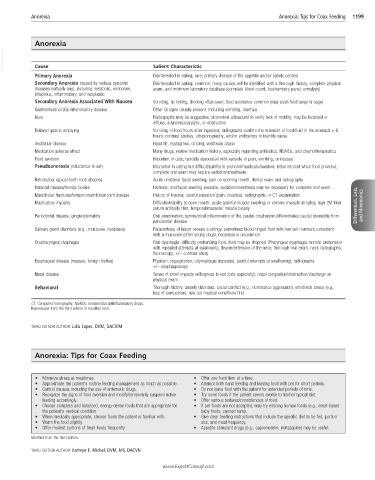Page 2421 - Cote clinical veterinary advisor dogs and cats 4th
P. 2421
Anorexia Anorexia: Tips for Coax Feeding 1199
Anorexia
VetBooks.ir Cause Salient Characteristic
Primary Anorexia Disinterested in eating; rare; primary disease of the appetite and/or satiety centers
Secondary Anorexia caused by various systemic Disinterested in eating; common; many causes will be identified with a thorough history, complete physical
diseases (virtually any), including metabolic, endocrine, exam, and minimum laboratory database (complete blood count, biochemistry panel, urinalysis)
infectious, inflammatory, and neoplastic
Secondary Anorexia Associated With Nausea Vomiting, lip licking, drooling often seen; food avoidance common (may push food away in cage)
Gastrointestinal (GI) inflammatory disease Other GI signs usually present, including vomiting, diarrhea
Ileus Radiographs may be suggestive; abdominal ultrasound to verify lack of motility; may be localized or
diffuse, adynamic/paralytic, or obstructive
Delayed gastric emptying Vomiting of food hours after ingestion; radiographs confirm the retention of food/fluid in the stomach > 8
hours; contrast studies, ultrasonography, and/or endoscopy to identify cause
Vestibular disease Head tilt, nystagmus, circling, vestibular ataxia
Medication adverse effect Many drugs; review medication history, especially regarding antibiotics, NSAIDs, and chemotherapeutics
Food aversion Important in cats; typically associated with episode of pain, vomiting, or nausea
Pseudoanorexia (reluctance to eat) Interested in eating but difficult/painful to prehend/masticate/swallow; initial interest when food provided;
complete oral exam may require sedation/anesthesia
Retrobulbar (apical tooth root) abscess Acute unilateral facial swelling; pain on opening mouth; dental exam and radiographs
Intraoral masses/foreign bodies Halitosis; oral/facial swelling possible; sedation/anesthesia may be necessary for complete oral exam
Mandibular fractures/temporomandibular joint disease History of trauma; careful palpation (pain, crepitus); radiographic or CT examination
Masticatory myositis Difficulty/inability to open mouth; acute (painful muscle swelling) or chronic (muscle atrophy); high 2M fiber Differentials, Lists,
serum antibody titer; temporal/masseter muscle biopsy and Mnemonics
Periodontal disease, gingivostomatitis Oral examination; symmetrical inflammation of the caudal oropharynx differentiates caudal stomatitis from
periodontal disease
Salivary gland disorders (e.g., mucocele, neoplasia) Paracentesis of lesion reveals a stringy, sometimes blood-tinged fluid with low cell numbers consistent
with a mucocele (often young dogs); neoplasia is uncommon
Oropharyngeal dysphagia Oral dysphagia: difficulty prehending food, food may be dropped. Pharyngeal dysphagia: normal prehension
with repeated attempts at swallowing, flexion/extension of the neck; thorough oral exam, neck radiographs,
fluoroscopy, +/− contrast study
Esophageal disease (masses, foreign bodies) Ptyalism; regurgitation; odynophagia (repeated, painful attempts at swallowing); radiographs
+/− esophagoscopy
Nasal disease Sense of smell impacts willingness to eat (cats especially); nasal congestion/obstruction/discharge on
physical exam
Behavioral Thorough history; anxiety disorders; social conflict (e.g., dominance aggression); emotional stress (e.g.,
loss of companion); rule out medical conditions first
CT, Computed tomography; NSAIDs, nonsteroidal antiinflammatory drugs.
Reproduced from the third edition in modified form.
THIRD EDITION AUTHOR: Julio Lopez, DVM, DACVIM
Anorexia: Tips for Coax Feeding
• Minimize stress at mealtimes. • Offer one food item at a time.
• Approximate the patient’s routine feeding management as much as possible. • Attempt both hand feeding and leaving food with pet for short periods.
• Control nausea, including the use of antemetic drugs. • Do not leave food with the patient for extended periods of time.
• Recognize the signs of food aversion and modify/temporarily suspend active • Try novel foods if the patient seems averse to his/her typical diet.
feeding accordingly. • Offer various textures/consistencies of food.
• Choose complete and balanced, energy-dense foods that are appropriate for • If pet foods are not accepted, may try enticing human foods (e.g., meat-based
the patient’s medical condition. baby foods, canned tuna).
• When medically appropriate, choose foods the patient is familiar with. • Give clear feeding instructions that include the specific diet to be fed, portion
• Warm the food slightly. size, and meal frequency.
• Offer modest portions of fresh foods frequently. • Appetite stimulant drugs (e.g., capromorelin, mirtazapine) may be useful.
Modified from the third edition.
THIRD EDITION AUTHOR: Kathryn E. Michel, DVM, MS, DACVN
www.ExpertConsult.com

